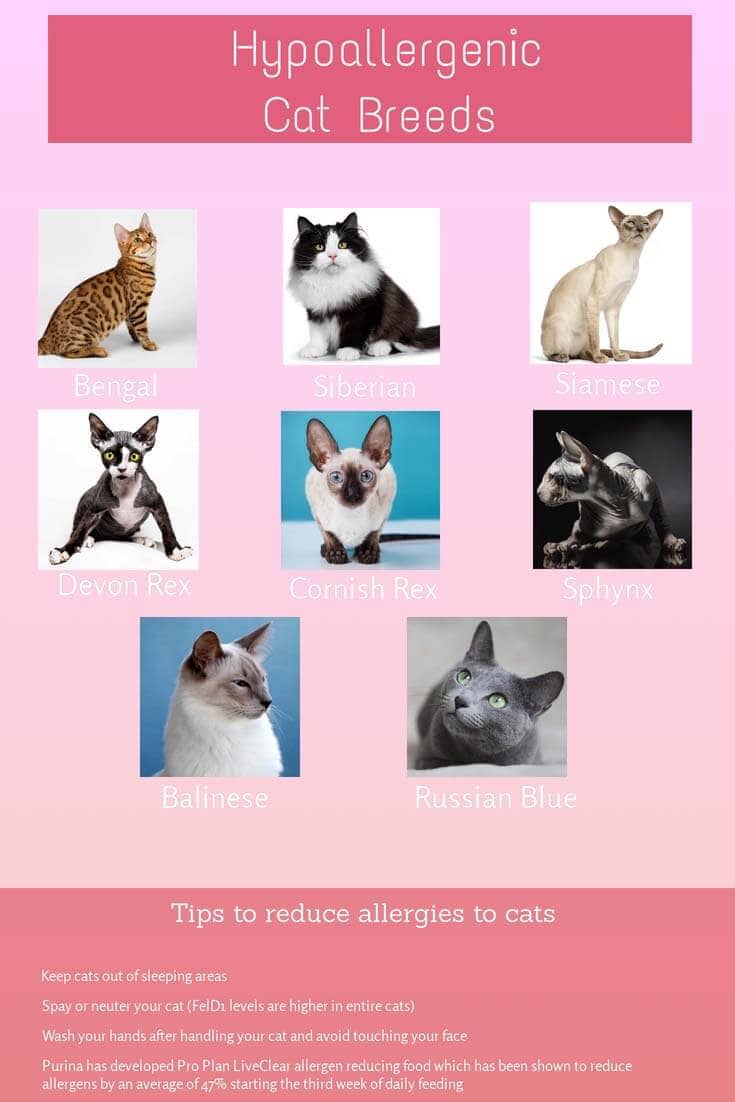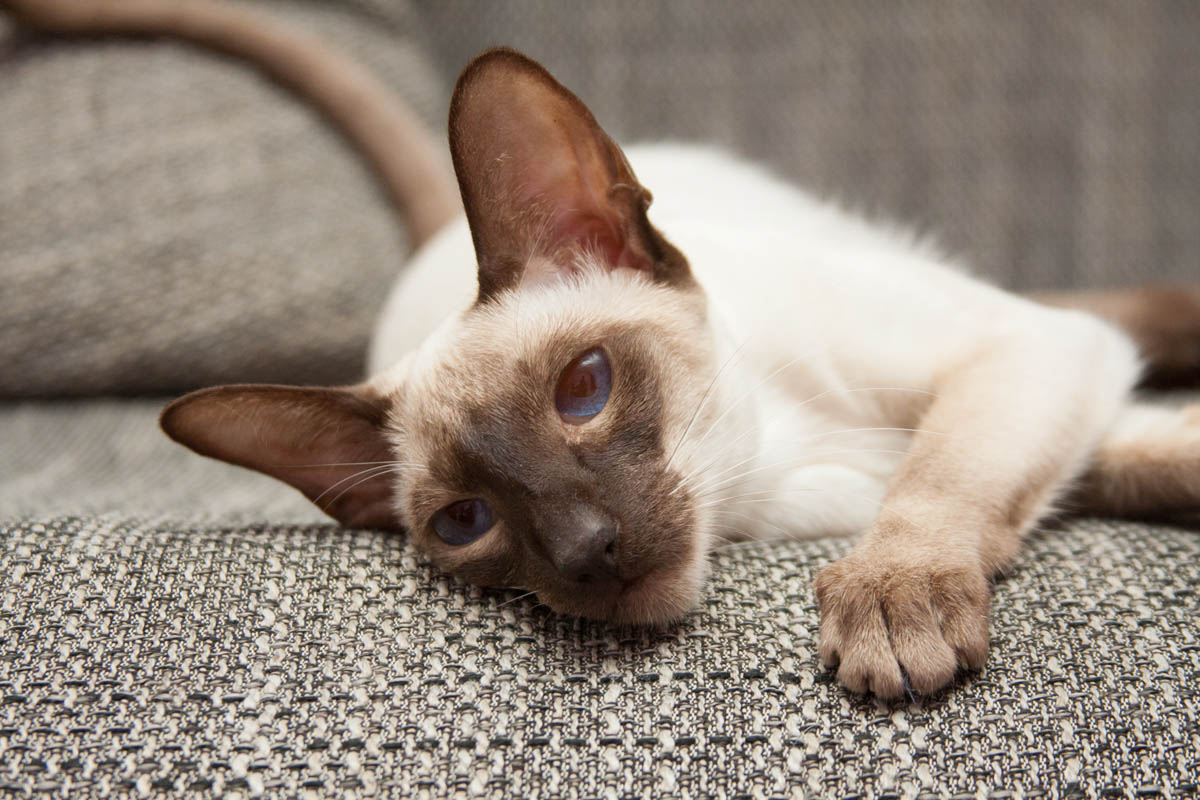Allergies to cats can be a major issue for animal lovers who want to adopt a cat but experience allergic reactions and are also a major reason cats are relinquished to shelters. No cat is truly hypoallergenic, but the breeds highlighted in this article may trigger fewer allergic reactions.
Hypoallergenic cat breeds
Siamese
- Activity: Moderate
- Coat: Short
- Weight: Males 5 – 6 (11 – 13.2 lbs), females 4.5 – 5.5 kg (9.9 – 12.1 lbs)
The Siamese is one of the most well-recognised cat breeds with its dark points on a pale body and stunning blue eyes. Siamese cats are extremely intelligent and loyal, who will often form close bonds with one particular member of the family. They are a talkative breed and love to have a conversation with their favourite human. Due to their intelligence, most Siamese cats can be taught to walk on a harness or play fetch.
Related breeds: Oriental shorthair, Oriental longhair, Balinese, Javanese, Colourpoint Shorthair
Siberian

- Activity: Moderate
- Coat: Long
- Weight: Males 5.5 – 7 kg (12.1 – 15.4 lbs), females 5 – 6 kg (11 – 13.2 lbs)
A natural breed of cat from Russia, the Siberian is a large, longhaired cat who are very personable and love to spend time with their human companion. There is no concrete proof the Siberian is indeed a hypoallergenic breed, but many breeders have reported anecdotally that allergy sufferers have had success with Siberian cats.
Related breeds: Neva Masquerade
Devon Rex

- Activity: Moderate to high
- Coat: Short (rexed)
- Weight: Males 4.5-5.5 kg (9.9 – 12.1 lbs), females 4.5 – 5 kg (9.9 – 11 lbs)
The Devon Rex is a short-coated cat who arose from a spontaneous mutation from a stray tomcat who lived near a mine in Buckfastleigh, Devon. Devons are friendly, outgoing, active, and get along with absolutely everyone including children and other pets.
The coat of the Devon Rex contains all three types of hair, guard, awn and down, however, the guard hair is sparse, short and rexed.
Cornish Rex

- Activity: High
- Coat: Short (rexed)
- Weight: Males 4.5-5.5 kg (9.9 – 12.1 lbs), females 4.5 – 5 kg (9.9 – 11 lbs)
Quiet, outgoing and extremely outgoing, the people-loving personality of the Cornish Rex means they like to be a part of the family. Their high energy level continues well into adulthood and Cornish Rex cats love to be up high, riding on their human’s shoulders or climbing. Due to their easygoing personality, the Cornish Rex makes the perfect family pet.
The Cornish Rex has a Roman nose and a coat that forms ripples known as a Marcel wave. The coat of the Cornish Rex is primarily made up of down hairs, with few awn and no guard hairs. The gene responsible for the Cornish Rex coat is different from that of the Devon Rex. These genes have been assigned Gene 1 (Cornish Rex) and Gene 2 (Devon Rex).
Sphynx
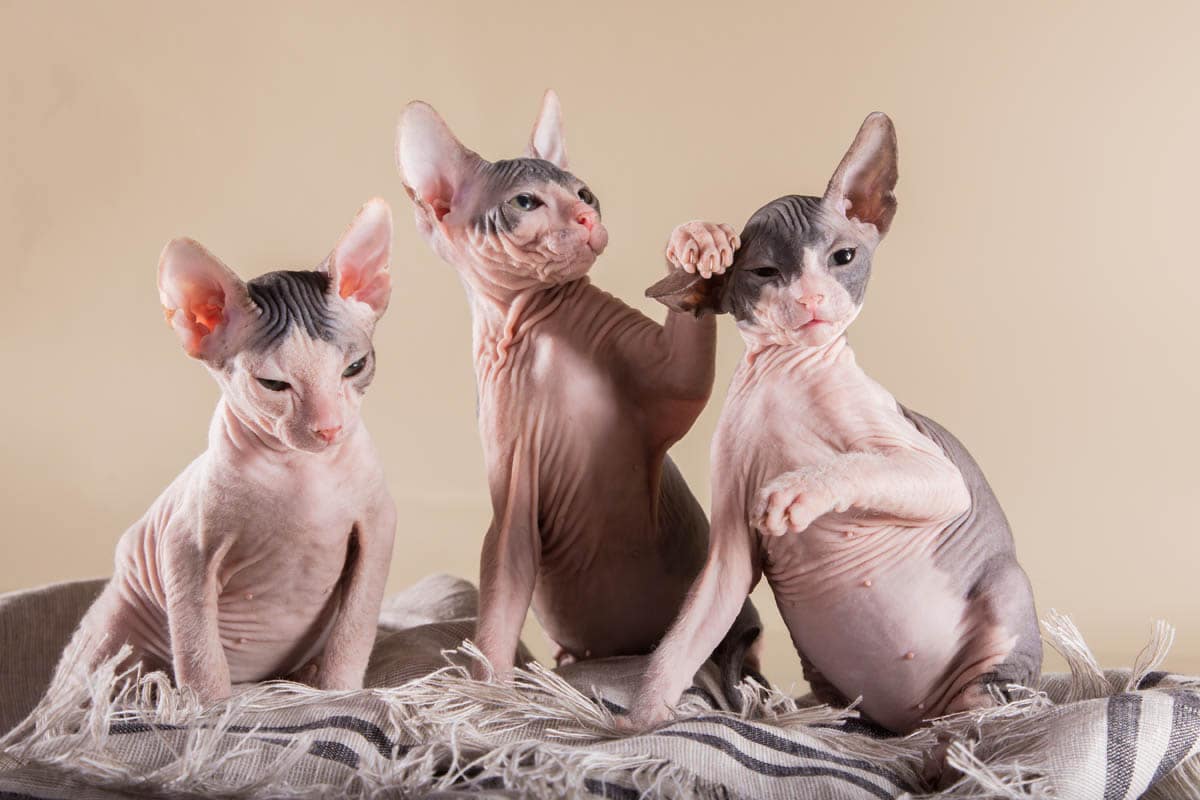
- Activity: Moderate to high
- Coat: Hairless (with a small amount of fuzz)
- Weight: Males 4.5 – 5.5 kg (9.9 – 12.1 lbs), females 4 – 5 kg (8.8 – 11 lbs)
Although they look bald, many Sphynx cats have a beautiful peach-like fuzz over their body which feels like soft chamois. These hairs are often described as ‘vellus hairs’, but I have found no credible information to back up this claim.
Sphynx cats are outgoing, friendly, mischievous and love to climb. A Sphynx cat will greet you at the door when you get home. They get along well with children and other family pets and their intelligence makes them easy to train. Due to their people-oriented personality, they do not like to be left alone for extended periods.
Related breeds: Minskin, Bambino, Elf, Dwelf
Other hairless breeds: Don Sphynx (Donskoy), Peterbald, Ukrainian Levkoy
Bengal
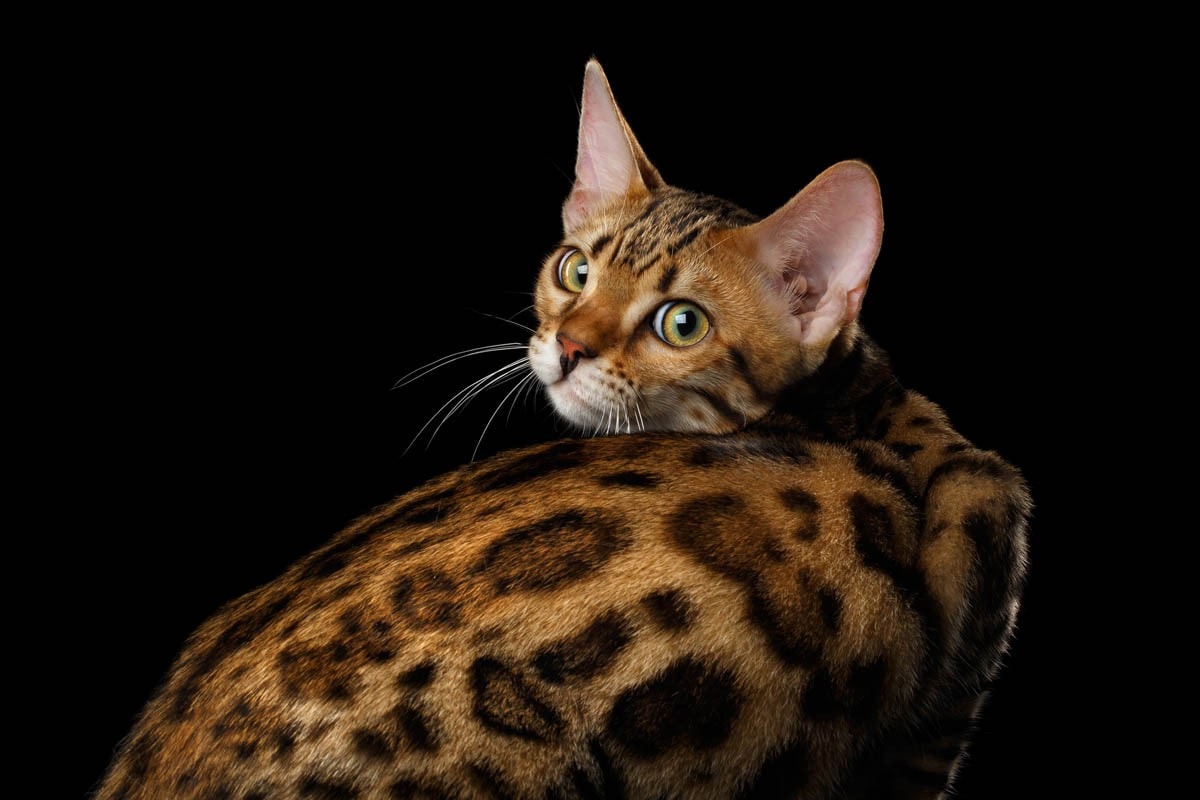
- Activity: Moderate to high
- Coat: Short
- Weight: Males 5 – 6 (11 – 13.2 lbs), females 5 – 5.5 kg (11 – 12.1 lbs)
The Bengal originated as a hybrid between the Asian leopard cat and domestic cats. They still maintain their wild look but with the nature of a domestic cat.
Bengals are extremely intelligent, energetic, love heights and thrive on human companionship and are known to love to drink water from a tap or sink.
The coat of the Bengal is incredibly soft and is often described as a pelt. It has a unique feature known as ‘glitter’, which catches and reflects light.
Related breeds: Toyger
Russian Blue
- Activity: Moderate
- Coat: Short
- Weight: Males 5 – 6 kg (11 – 13.2 lbs), females 4.5 – 5 kg (9.9 – 11 lbs)
One of the oldest domestic breeds of cat, the Russian Blue is a quiet, devoted breed of cat who loves to be close to their human companion. The Russian Blue is moderate in every way; they are not vocal; clingy, highly active, nor are they lazy.
Russian blues have a short, dense coat that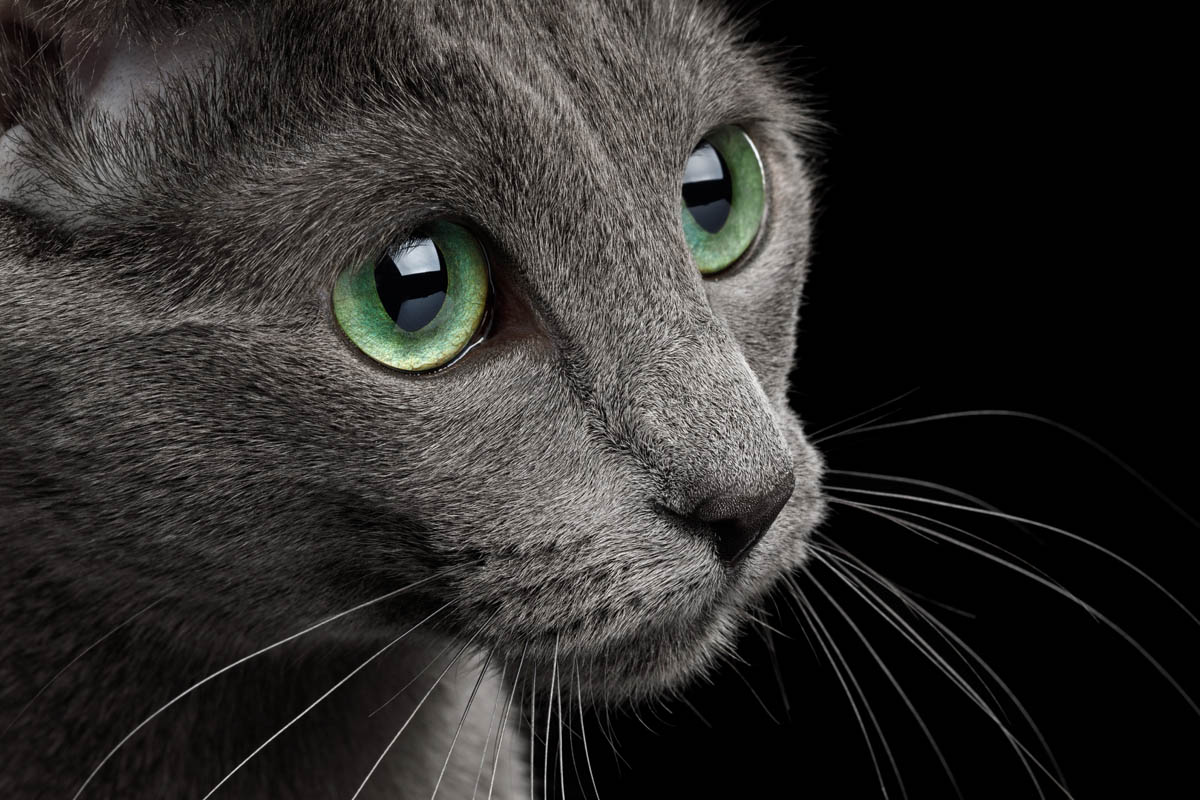 tends to shed less and produce less Fel d1 than other breeds.
tends to shed less and produce less Fel d1 than other breeds.
Related breeds: Russian Blue and Russian Black
Balinese
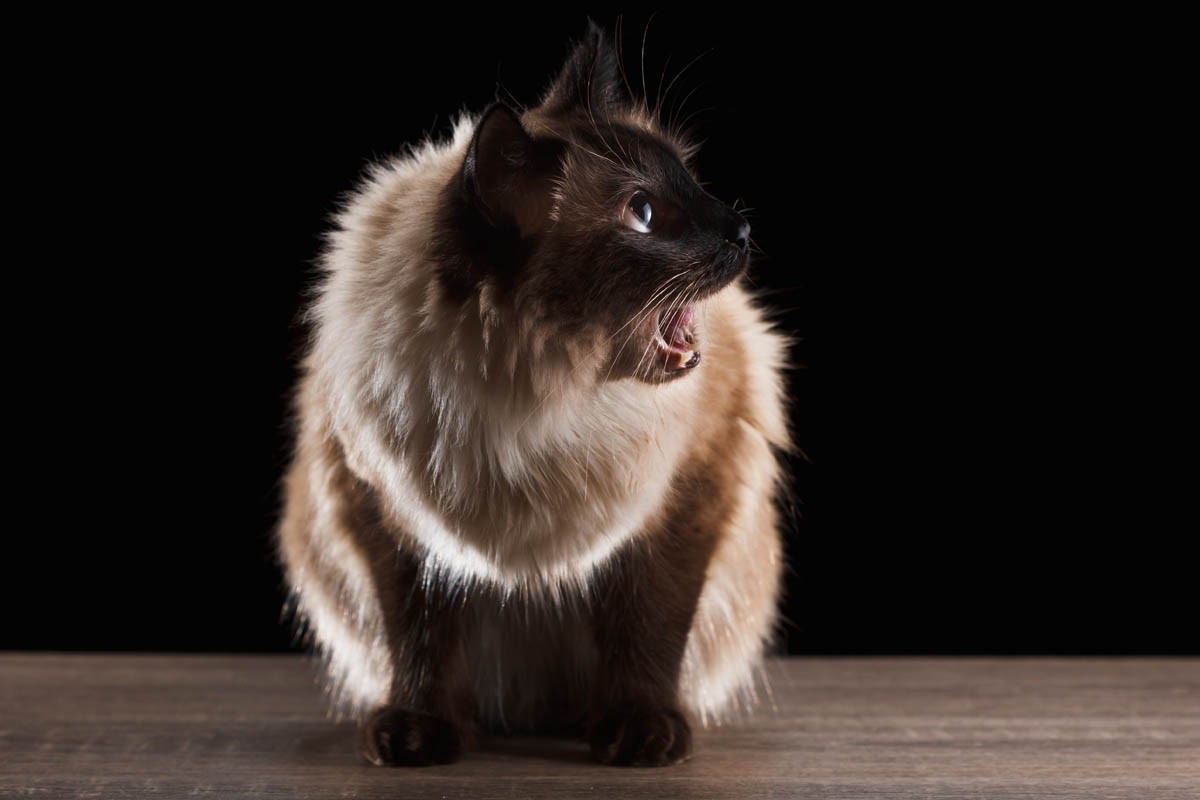
- Activity: Moderate
- Coat: Semi-longhair
- Weight: Males 5 – 6 kg (11 – 13.2 lbs), females 4.5 – 5 kg (9.9 – 11 lbs)
The beautiful Balinese is a longhaired Siamese who shares many common traits with their Siamese cousin. Balinese cats are intelligent, outgoing, people-oriented and talkative and will follow you from room to room. Their intelligence makes them easy to train to walk on a harness or play fetch. While the Balinese cat loves to talk, they are less vocal than the Siamese.
The coat of the Balinese is semi-longhair, soft and silky with no undercoat.
Related breeds: Javanese, Siamese
Frequently asked questions
What causes allergies
The primary cause of allergies to cats is a glycoprotein known as Fel D1 which is produced by the sebaceous glands under the skin, and to a lesser degree is present in the cat’s saliva.
A cat is constantly shedding minute particles of dander (skin flakes) into the environment, and when the grooms, saliva is transferred onto the coat, which is then shed around the home producing allergies in those susceptible.
Related: Cat breeds that shed the least
What makes these breeds more hypoallergenic?
The Rex and Sphynx cats have less fur (Sphynx cats have a peach-like fuzz) and therefore less is shed into the environment. While Rex and Sphynx cats shed less fur, they still shed dander (skin flakes) which contain the Fel d1 protein.
The other hypoallergenic cat breeds are thought to produce less Fel d1 than other breeds of cat. This has yet to be proven with clinical trials, however, many cat owners and breeders substantiate this claim.
Most cats shed all year round, with a more substantial shed around springtime. I recently spoke to a Siberian cat breeder who said that Siberian cats tend to shed less year-round, but instead shed twice a year heavily. She reported that in her experience, the breed has been good for allergy sufferers.
Are some coat colours less likely to cause allergies?
Coat colour has no impact on the level of danger, one study identified lower levels of salivary Fel d1 in older cats.
Male vs female cat
Entire male cats produce more Fel d1 than female cats (either entire or spayed).
What are the symptoms of cat allergies?
Symptoms vary depending on the severity of the allergy but may include:
- Itchy, red, watery eyes
- Runny nose
- Coughing
- Wheezing
- Chest tightness
- Hives
If you are not sure that you are suffering from an allergy to cats, you can request an allergy test, which involves either a skin patch test or a blood test.
As we discussed in our previous article hypoallergenic cats, do they exist? There are no true hypoallergenic breeds of cat, however, there are some breeds of cat that may trigger fewer allergy symptoms in affected people.
How to reduce allergies to cats
- Fel d 1 levels on the skin of the cat are dramatically higher in the facial area than the chest. Make sure you wash that face well.
- The use of allergy wipes such as Allerpet has proved effective in reduces cat allergens on the cat and thus your home (studies showed that it was effective for around 80% of its users).
- Ensure the cat is spayed or neutered.
- Wash your hands after handling your cat and avoid touching your face or eyes.
- Wash clothes frequently and wear more cotton and less wool.
- Keep the house as clean as possible by washing floors and bed linen often with hot water to eliminate the allergens.
- Wash clothes and bed linen using detergent solutions at 25°C (77°F) for at least 5 minutes – to extract cat allergen from bedding and clothing.
- Use dusting sprays whilst dusting to minimise dust spread.
- Carpet is more likely to hold allergens – so if you can remove it in favour of wood, vinyl or tile floors.
- Avoid heavy drapes that trap allergens and dust.
- Keep the cat out of your bedroom and laundry (keep it off your clean clothes) and provide it with its own bed.
- Purina has developed Pro Plan LiveClear allergen reducing cat food which has been shown to reduce the allergens in cat hair and dander by an average of 47% starting in the third week of daily feeding.
Points to consider
Unfortunately, there are no guarantees with any cat breed if you suffer from an allergy to cats. A leading cause of Rex cats being surrendered is that they were purchased with the belief they would be allergy-free and the new family still suffered from cat allergies. You can do your best to reduce your chances by adopting from the list of cats LESS LIKELY to cause allergies, choosing a lighter coated cat, a desexed male or female, but even with all of this, they still may trigger problems.
Visit cat shows and talk to cat breeders. If they claim their breed is hypoallergenic, see for yourself by spending time with the breed(s). It must be noted that even if you do visit a cat show or a cat breeder and experience no problems with allergies, they can develop with prolonged or repeated exposure.
If allergies become a problem, speak to your doctor as are many ways to relieve symptoms and ways you can reduce exposure to allergens within the home.
Please share our infographic
